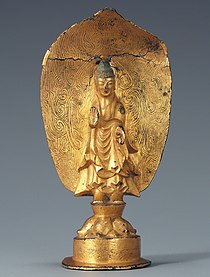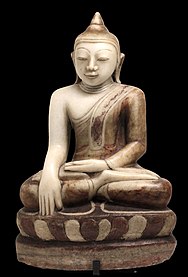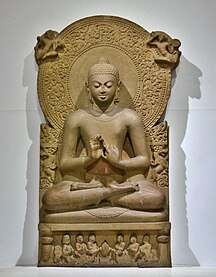Mudra


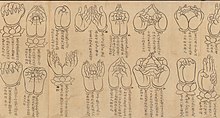
Amudra(/muˈdrɑː/;Sanskrit:मुद्रा,IAST:mudrā,"seal", "mark", or "gesture";Tibetan:ཕྱག་རྒྱ་,THL:chakgya) is a symbolic or ritual gesture or pose inHinduism,JainismandBuddhism.[1]While some mudras involve the entire body, most are performed with the hands and fingers.[2]
As well as being spiritual gestures employed in theiconographyandspiritual practiceofIndian religions,mudras have meaning in many forms ofIndian dance,andyoga.The range of mudras used in each field (and religion) differs, but with some overlap. In addition, many of the Buddhist mudras are used outsideSouth Asia,and have developed different local forms elsewhere.
Inhatha yoga,mudras are used in conjunction withpranayama(yogic breathing exercises), generally while in a seated posture, to stimulate different parts of the body involved with breathing and to affect the flow ofprana.It is also associated withbindu,bodhicitta,amrita,or consciousness in the body. Unlike older tantric mudras, hatha yogic mudras are generally internal actions, involving the pelvic floor, diaphragm, throat, eyes, tongue, anus, genitals, abdomen, and other parts of the body. Examples of this diversity of mudras areMula Bandha,Mahamudra,Viparita Karani,Khecarī mudrā,andVajroli mudra.These expanded in number from 3 in theAmritasiddhi,to 25 in theGheranda Samhita,with a classical set of ten arising in theHatha Yoga Pradipika.
Mudra is used in theiconographyofHinduandBuddhist artof theIndian subcontinentand described in the scriptures, such asNātyaśāstra,which lists 24asaṁyuta( "separated", meaning "one-hand" ) and 13saṁyuta( "joined", meaning "two-hand" ) mudras. Mudra positions are usually formed by both the hand and the fingers. Along withāsanas( "seated postures" ), they are employed statically in themeditationand dynamically in theNāṭyapractice of Hinduism.
Hindu and Buddhist iconography share some mudras. In some regions, for examplein Laos and Thailand,these are distinct but share related iconographic conventions.
According toJamgön Kongtrülin his commentary on theHevajra Tantra,the ornaments ofwrathful deitiesand witches made of human bones (Skt:aṣṭhimudrā;Wylie:rus pa'i rgyan phyag rgya) are also known as mudra "seals".[3]
Etymology and nomenclature
[edit]The word mudrā hasSanskritroots. According to scholarSir Monier Monier-Williamsit means "seal" or "any other instrument used for sealing".[4]
Buddhist Iconography
[edit]A Buddha image can have one of several common mudras, combined with different asanas. The main mudras used represent specific moments in the life of theBuddha,and are shorthand depictions of these.
Abhaya Mudrā
[edit]TheAbhayamudra"gesture of fearlessness"[5]represents protection, peace, benevolence and the dispelling of fear. InTheravada Buddhismit is usually made while standing with the right arm bent and raised to shoulder height, the palm facing forward, the fingers closed, pointing upright and the left hand resting by the side. In Thailand and Laos, this mudra is associated with theWalking Buddha,sometime also shown having both hands making a double abhaya mudra that is uniform.
This mudra was probably used before the onset of Buddhism as a symbol of good intentions proposing friendship when approaching strangers. InGandharan art,it is seen when showing the action of preaching. It was also used in China during theWeiandSuieras of the 4th and 7th centuries.
This gesture was used by the Buddha when attacked by an elephant, subduing it as shown in severalfrescoesand scripts.[6]
InMahayana Buddhism,the deities are often portrayed as pairing the Abhaya Mudrā with another Mudrā using the other hand.
Bhūmisparśa Mudrā
[edit]Thebhūmisparśaor "earth witness" mudra ofGautama Buddhais one of the most common iconic images of Buddhism. Other names include "Buddha calling the earth to witness", and "earth-touching". It depicts the story from Buddhist legend of the moment when Buddha attained completeenlightenment,with Buddha sitting in meditation with his left hand, palm upright, in his lap, and his right hand touching the earth. In the legend, Buddha was challenged by the evil one,Mara,who argue for a witness to attest his right to achieve it. In response to Mara, Buddha touched the ground, andPhra Mae Thorani,the earth goddess, appeared to be the witnesses for the Buddha's enlightenment.[7][8]
In East Asia, this mudra (also called theMaravijaya attitude) may show Buddha's fingers not reaching as far as the ground, as is usual in Burmese or Indian depictions.
Bodhyangi Mudrā
[edit]TheBodhyangi mudrā,the "mudrā of the six elements," or the "fist of wisdom,"[9]is a gesture entailing the left-hand index finger being grasped with the right hand. It is commonly seen on statues of theVairocanaBuddha.
Dharmachakra Pravartana Mudrā
[edit]The Buddha preached his first sermon after his Enlightenment in Deer Park inSarnath.ThedharmachakraPravartana or "turning of the wheel"[10]mudrā represents that moment. In general, only Gautama Buddha is shown making this mudrā exceptMaitreyaas the dispenser of the Law. Dharmachakra mudrā is two hands close together in front of the chest invitarkawith the right palm forward and the left palm upwards, sometimes facing the chest. There are several variants such as in theAjanta Cavesfrescoes, where the two hands are separated and the fingers do not touch. In theIndo-Greek styleofGandhara,the clenched fist of the right hand seemingly overlies the fingers joined to the thumb on the left hand. In pictorials ofHōryū-jiin Japan the right hand is superimposed on the left. Certain figures ofAmitābhaare seen using this mudra before the 9th century in Japan.
Dhyāna Mudrā
[edit]Thedhyānamudrā( "meditation mudra" ) is the gesture of meditation, of the concentration of the Good Law and thesangha.The two hands are placed on the lap, right hand on left with fingers fully stretched (four fingers resting on each other and the thumbs facing upwards towards one another diagonally), palms facing upwards; in this manner, the hands and fingers form the shape of a triangle, which is symbolic of the spiritual fire or theThree Jewels. This mudra is used in representations ofGautama BuddhaandAmitābha.Sometimes the dhyāna mudrā is used in certain representations ofBhaiṣajyaguruas the "Medicine Buddha", with a medicine bowl placed on the hands. It originated in India most likely inGandhāraand in China during theNorthern Wei.
It is heavily used in Southeast Asia inTheravada Buddhism;however, the thumbs are placed against the palms. Dhyāna mudrā is also known as "samādhimudrā "or" yoga mudrā ",Chinese:Thiền định ấn;pinyin:[Chán]dìng yìn;Japanese pronunciation:jōin, jōkai jōin[citation needed].
Themida no jōin( di đà định ấn ) is the Japanese name of a variation of the dhyāna mudra, where the index fingers are brought together with the thumbs. This was predominantly used in Japan in an effort to distinguish Amitābha (hence "mida" from Amida) from the Vairocana Buddha,[11]and was rarely used elsewhere.
Varada Mudrā
[edit]TheVaradamudrā"generosity gesture" signifies offering, welcome, charity, giving, compassion and sincerity. It is nearly always shown made with the left hand by a revered figure devoted to human salvation from greed, anger and delusion. It can be made with the arm crooked and the palm offered slightly turned up or in the case of the arm facing down the palm presented with the fingers upright or slightly bent. The Varada mudrā is rarely seen without another mudra used by the right hand, typically abhaya mudrā. It is often confused with vitarka mudrā, which it closely resembles. In China and Japan during theNorthern WeiandAsuka periods,respectively, the fingers are stiff and then gradually begin to loosen as it developed over time, eventually leading to theTang dynastystandard where the fingers are naturally curved.
InIndia,varada mudra is used by both seated and standing figures, of Buddha and boddhisattvas and other figures, and in Hindu art is especially associated withVishnu.It was used in images ofAvalokiteśvarafromGupta art(4th and 5th centuries) onwards. Varada mudrā is extensively used in the statues ofSoutheast Asia.
Vajra Mudrā
[edit]TheVajramudrā"thunder gesture" is the gesture of knowledge.[12]
Vitarka Mudrā
[edit]TheVitarka mudrā"mudra of discussion" is the gesture of discussion and transmission of Buddhist teaching. It is done by joining the tips of the thumb and the index together, and keeping the other fingers straight very much like the abhaya and varada mudrās but with the thumbs touching the index fingers. This mudra has a great number of variants inMahayana Buddhism.InTibetan Buddhism,it is the mystic gesture ofTārāsandbodhisattvaswith some differences by the deities inYab-Yum.Vitarka mudrā is also known asVyākhyāna mudrā( "mudra of explanation" ). This is also called as chin-mudra.[13]
Jñāna Mudrā
[edit]
TheJñāna mudrā( "mudra of wisdom" ) is done by touching the tips of the thumb and the index together, forming a circle, and the hand is held with the palm inward towards the heart.[14]The mudra representsspiritual enlightenmentin theindian-origin religions.Sometimessadhuschose to be buried alive in thissamadhiposition. A 2700 old skeleton arranged like this was found atBalathalin Rajasthan, suggesting that something like yoga may have existed at that time.[15]
Karana Mudrā
[edit]Thekarana mudrāis the mudra which expels demons and removes obstacles such as sickness or negative thoughts. It is made by raising the index and the little finger, and folding the other fingers. It is nearly the same as the Western "sign of the horns",the difference is that in the Karana mudra the thumb does not hold down the middle and ring finger. This mudra is also known astarjanī mudrā.
Gallery
[edit]-
The Buddha sitting in bhūmisparśa mudrā. Birmany. White marble with traces of polychromy.Gallo-Roman Museum of Lyon-Fourvière
-
Bodhyangi Mudrā
-
A statue of the Buddha fromSarnath,Uttar Pradesh,India, 4th century CE. The Buddha is depicted teaching, while making the Dharmacakra Pravartana mudrā.
-
Vajra Mudrā
-
Vitarka mudrā,Tarim Basin,9th century
-
Joseonfigure displays the karana mudrā.
Indian classical dance
[edit]InIndian classical danceand derived dances (such asKhmer,ThaiorBalinese),[16]the term "Hasta Mudra" is used (although, there are terms used for mudras in derived dances). TheNatya Shastradescribes 24 mudras, while theAbhinaya DarpanaofNandikeshvaragives 28.[17]In all their forms of Indian classical dance, the mudras are similar, though the names and uses vary. There are 28 (or 32) root mudras inBharatanatyam,24 inKathakaliand 20 inOdissi.These root mudras are combined in different ways, like one hand, two hands, arm movements, body and facial expressions. InKathakali,which has the greatest number of combinations, the vocabulary adds up to c. 900. Sanyukta mudras use both hands and asanyukta mudras use one hand.[18]In Thai dances, there are 9 mudras.
Yoga
[edit]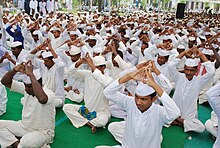

The classical sources for the yogic seals are theGheranda Samhitaand theHatha Yoga Pradipika.[19]TheHatha Yoga Pradipikastates the importance of mudras in yoga practice: "Therefore the [Kundalini] goddess sleeping at the entrance of Brahma's door [at the base of the spine] should be constantly aroused with all effort, by performing mudra thoroughly. "In the 20th and 21st centuries, the yoga teacherSatyananda Saraswati,founder of theBihar School of Yoga,continued to emphasize the importance of mudras in his instructional textAsana, Pranayama, Mudrā, Bandha.[19]
Hand Gestures
[edit]There are numerous hand gesturemudrasin yoga. Each of the hand gestures is based on the concept of the five elements as they relate to one's fingers.
Hatha Yoga
[edit]The yoga mudras are diverse in the parts of the body involved and in the procedures required, as inMula Bandha,[20]Mahamudra,[21]Viparita Karani,[22]Khecarī mudrā,[23]andVajroli mudra.[24]
Mula Bandha
[edit]
Mula Bandha, the Root Lock, consists of pressing one heel into the anus, generally in a cross-legged seated asana, and contracting theperineum,forcing the prana to enter the centralsushumnachannel.[20]
Mahamudra
[edit]Mahamudra, the Great Seal, similarly has one heel pressed into the perineum; the chin is pressed down to the chest inJalandhara Bandha,the Throat Lock, and the breath is held with the body's upper and lower openings both sealed, again to force the prana into the sushumna channel.[21]
Viparita Karani
[edit]Viparita Karani, the Inverter, is a posture with the head down and the feet up, using gravity to retain the prana. Gradually the time spent in the posture is increased until it can be held for "three hours". The practice is claimed by theDattatreyayogashastrato destroy all diseases and to banish grey hair and wrinkles.[22]
Khechari mudra
[edit]Khecarī mudrā, the Khechari Seal, consists of turning back the tongue "into the hollow of the skull",[23]sealing in thebindufluid so that it stops dripping down from the head and being lost, even when the yogi "embraces a passionate woman".[23]To make the tongue long and flexible enough to be folded back in this way, theKhecharividyaexhorts the yogi to make a cut a hair's breadth deep in thefrenulum of the tongueonce a week. Six months of this treatment destroys the frenulum, leaving the tongue able to fold back; then the yogi is advised to practise stretching the tongue out, holding it with a cloth, to lengthen it, and to learn to touch each ear in turn, and the base of the chin. After six years of practice, which cannot be hurried, the tongue is said to become able to close the top end of the sushumna channel.[26]
Vajroli mudra
[edit]Vajroli mudra, the Vajroli Seal, requires the yogi to preserve thesemen,either by learning not to release it, or if released by drawing it up through theurethrafrom thevaginaof "a woman devoted to the practice of yoga".[27]
Martial arts
[edit]SomeAsian martial artsforms contain positions (Japanese:in) identical to these mudras.[28]TendaiandShingon Buddhismderived the supposedly powerful gestures from Mikkyo Buddhism, still to be found in manyKo-ryū( "old" ) martial artsRyū(schools) founded before the 17th century. For example the "knife hand" orshutogesture is subtly concealed in some Koryu kata, and in Buddhist statues, representing the sword of enlightenment.[29]
See also
[edit]- Chironomia
- Gesticulation in Italian
- Iconography of Gautama Buddha in Laos and Thailand
- Kuji-in
- Kuji-kiri
- List of mudras (dance)
- List of mudras (yoga)
- Mahamudra
- Naga Prok attitude
- Pranahuti
- Pranāma
- Reflexology
- Tea ceremony
- Yogamudrasana,a variant of lotus pose that is both an asana and a mudra
Notes
[edit]- ^Encyclopædia Britannica.(2010)."mudra (symbolic gestures)".Retrieved October 11, 2010.
- ^"Wordmudrāon Monier-William Sanskrit-English on-line dictionary: "N. of partic. positions or intertwinings of the fingers (24 in number, commonly practised in religious worship, and supposed to possess an occult meaning and magical efficacyDaś(Daśakumāra-carita).Sarvad.Kāraṇḍ.RTL. 204; 406) "".Archived fromthe originalon 2012-12-03.Retrieved2012-05-13.
- ^Kongtrul, Jamgön(author); (English translators: Guarisco, Elio; McLeod, Ingrid) (2005).The Treasury of Knowledge (shes bya kun la khyab pa’i mdzod). Book Six, Part Four: Systems of Buddhist Tantra, The Indestructibe Way of Secret Mantra.Bolder, Colorado, USA: Snow Lion Publications.ISBN1-55939-210-X(alk.paper) p.493
- ^Monier-Williams, Monier(1872). "Mudra".A Sanskrit-English Dictionary.Clarendon.
- ^Buswell, Robert Jr.,ed. (2013).Princeton Dictionary of Buddhism.Princeton, NJ: Princeton University Press. p. 2.ISBN9780691157863.
- ^"Abhaya Mudra Gesture of Dispelling Fear".Retrieved2019-02-03.
One day the Buddha walked through a village. Devadatta fed alcohol to a particularly furious elephant named Nalagiri and had him attack the Buddha. The raging bull stormed towards the Buddha, who reached out his hand to touch the animal's trunk. The elephant sensed the metta, the loving kindness of the Buddha, which calmed him down immediately. The animal stopped in front of the Buddha and bowed on his knees in submission.
- ^Shaw, Miranda Eberle (2006).Buddhist Goddesses of India.Princeton University Press. pp.17–27.ISBN978-0-691-12758-3.
- ^Vessantara,Meeting the Buddhas: A Guide to Buddhas, Bodhisattvas, and Tantric Deities,pp. 74-76, 1993, Windhorse Publications,ISBN0904766535,9780904766530,google books
- ^T.W. Rhys Davids Ph.D. LLD.; Victoria Charles (24 November 2014).1000 Buddhas of Genius.Parkstone International. p. 515.ISBN978-1-78310-463-5.
- ^explanation of Buddhist Mudras
- ^Japanese Architecture and Art Net Users System."JAANUS / mida-no-jouin di đà định ấn".Retrieved 2 July 2016.
- ^written; Beer, illustrated by Robert (2003).The handbook of tibetan buddhist symbols(1st ed.). Chicago (Ill.): Serindia. p. 228.ISBN978-1932476033.
- ^https:// google.co.in/books/edition/Mudras_of_Yoga/NacaAwAAQBAJ?hl=en&gbpv=1&dq=chin+mudra&printsec=frontcover
- ^For translation ofjñānamudrāas "gesture of knowledge" see:Stutley 2003,p. 60.
- ^Shearer, Alistair (2020).The Story of Yoga:From Ancient India to the Modern West.London: Hurst Publishers. p. 19.ISBN978-1-78738-192-6.
- ^"Thai Classical Dance | Asian Traditional Theatre & Dance".2 October 2017.
- ^Devi, Ragini.Dance dialects of India.Motilal Banarsidass Publ., 1990.ISBN81-208-0674-3.Pp. 43.
- ^Barba & Savarese 1991,pp. 136
- ^abSaraswati, Satyananda (1997).Asana Pranayama Mudrā Bandha.Munger, Bihar India: Bihar Yoga Bharti. p. 422.ISBN81-86336-04-4.
- ^abMallinson & Singleton 2017,pp. 242.
- ^abMallinson & Singleton 2017,pp. 237–238, 241.
- ^abMallinson & Singleton 2017,pp. 242, 245.
- ^abcMallinson & Singleton 2017,pp. 241, 244–245.
- ^Mallinson & Singleton 2017,pp. 242, 250–252.
- ^Mallinson & Singleton 2017,pp. Chapter 6, especially pages 228–229.
- ^Mallinson & Singleton 2017,pp. 247–249.
- ^Mallinson & Singleton 2017,pp. 242–243, 250–252.
- ^Johnson 2000,p. 48.
- ^Muromoto, Wayne (2003)Mudra in the Martial ArtsArchived2007-12-15 at theWayback Machine..Retrieved December 20, 2007.
References
[edit]- Barba, Eugenio; Savarese, Nicola (1991).A dictionary of theatre anthropology: the secret art of the performer.London, United Kingdom: Routledge. p. 136.ISBN0-415-05308-0.
- Draeger, Donn (1980). "Esoteric Buddhism in Japanese Warriorship", in: No. 3. 'Zen and the Japanese Warrior' of theInternational Hoplological Society Donn F. Draeger Monograph Series.The DFD monographs are transcriptions of lectures presented by Donn Draeger in the late 1970s and early 1980s at the University of Hawaii and at seminars in Malaysia.
- Johnson, Nathan J. (2000).Barefoot Zen: The Shaolin Roots of Kung Fu and Karate.York Beach, USA: Weiser.ISBN1-57863-142-4.
- Mallinson, James;Singleton, Mark(2017).Roots of Yoga.Penguin Books.ISBN978-0-241-25304-5.OCLC928480104.
- Stutley, Margaret (2003) [1985].The Illustrated Dictionary of Hindu Iconography(First Indian ed.). New Delhi: Munshiram Manoharlal Publishers.ISBN81-215-1087-2.
Further reading
[edit]- Saunders, Ernest Dale(1985).Mudra: A Study of Symbolic Gestures in Japanese Buddhist Sculpture.Princeton University Press.ISBN978-0-691-01866-9.
- Hirschi, Gertrud.Mudras: Yoga in Your Hands.
- Taisen Miyata:A study of the ritual mudras in the Shingon tradition: A phenomenological study on the eighteen ways of esoteric recitation in the Koyasan tradition.Publisher s.n.
- Acharya Keshav Dev:Mudras for Healing; Mudra Vigyan: A Way of Life.Acharya Shri Enterprises, 1995.ISBN9788190095402.
- Gauri Devi:Esoteric Mudras of Japan.International. Academy of Indian Culture & Aditya Prakashan, 1999.ISBN9788186471562.
- Lokesh Chandra & Sharada Rani:Mudras in Japan.Vedams Books, 2001.ISBN9788179360002.
- Emma I. Gonikman:Taoist Healing Gestures.YBK Publishers, Inc., 2003.ISBN9780970392343.
- Fredrick W. Bunce:Mudras in Buddhist and Hindu Practices: An Iconographic Consideration.DK Printworld, 2005.ISBN9788124603123.
- A. S. Umar Sharif:Unlocking the Healing Powers in Your Hands: The 18 Mudra System of Qigong.Scholary, Inc, 2006.ISBN978-0963703637.
- Dhiren Gala:Health at Your Fingertips: Mudra Therapy, a Part of Ayurveda Is Very Effective Yet Costs Nothing.Navneet, 2007.ISBN9788124603123.
- K. Rangaraja Iyengar:The World of Mudras/Health Related and other Mudras.Sapna Book house, 2007.ISBN9788128006975.
- Suman K Chiplunkar:Mudras & Health Perspectives: An Indian Approach.Abhijit Prakashana, 2008.ISBN9788190587440.
- Acharya Keshav Dev:Healing Hands (Science of Yoga Mudras).Acharya Shri Enterprises, 2008.ISBN9788187949121.
- Cain Carroll and Revital Carroll:Mudras of India: A Comprehensive Guide to the Hand Gestures of Yoga and Indian Dance.Singing Dragon, 2012.ISBN9781848190849.
- Joseph and Lilian Le Page:Mudras for Healing and Transformation.Integratieve Yoga Therapy, 2013.ISBN978-0-9744303-4-8.
- Toki, Hôryû; Kawamura, Seiichi, tr. (1899)."Si-do-in-dzou; gestes de l'officiant dans les cérémonies mystiques des sectes Tendaï et Singon",Paris, E. Leroux.
- Adams, Autumn:The Little Book of Mudra Meditations.Rockridge Press, 2020.ISBN9781646114900.

